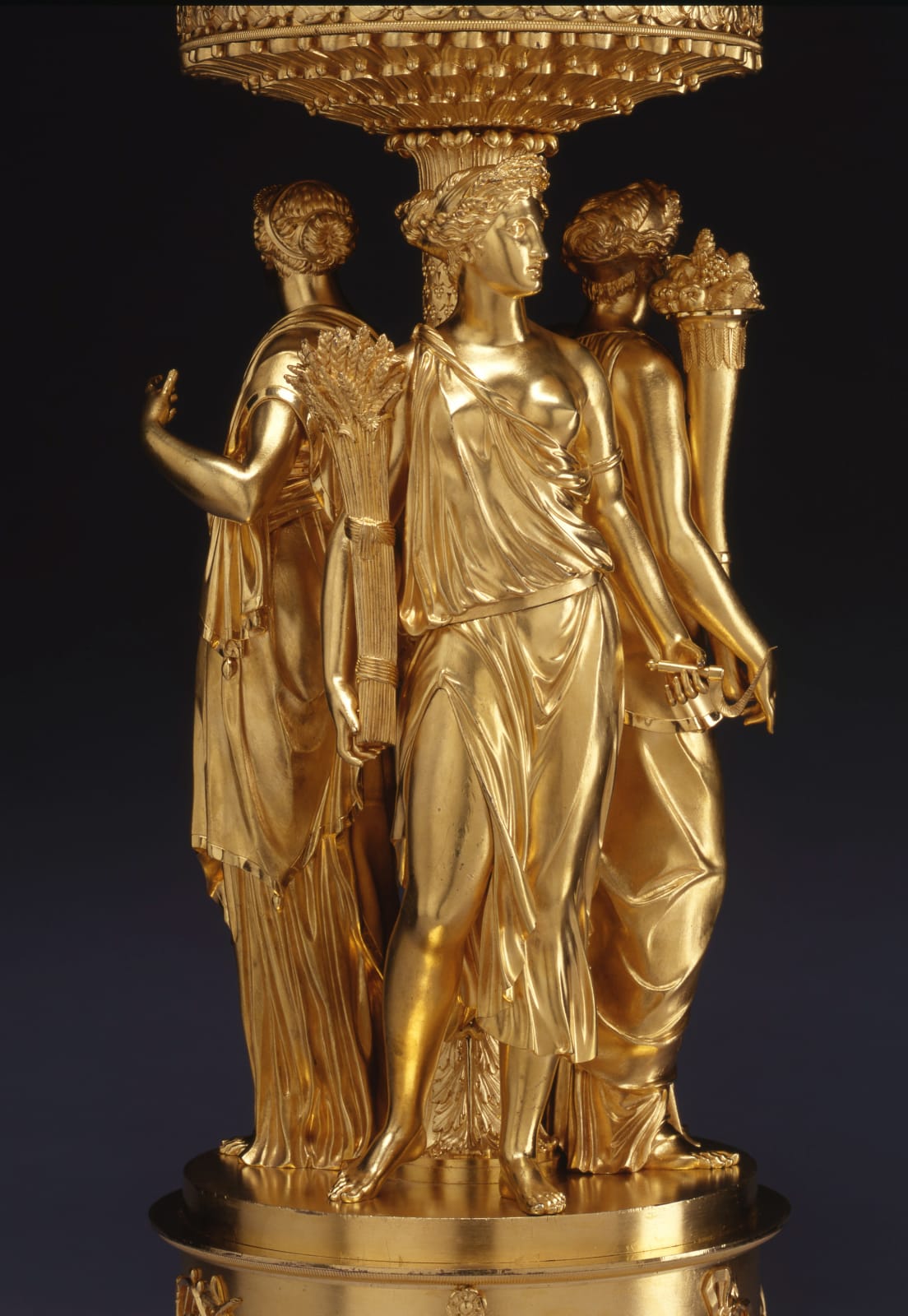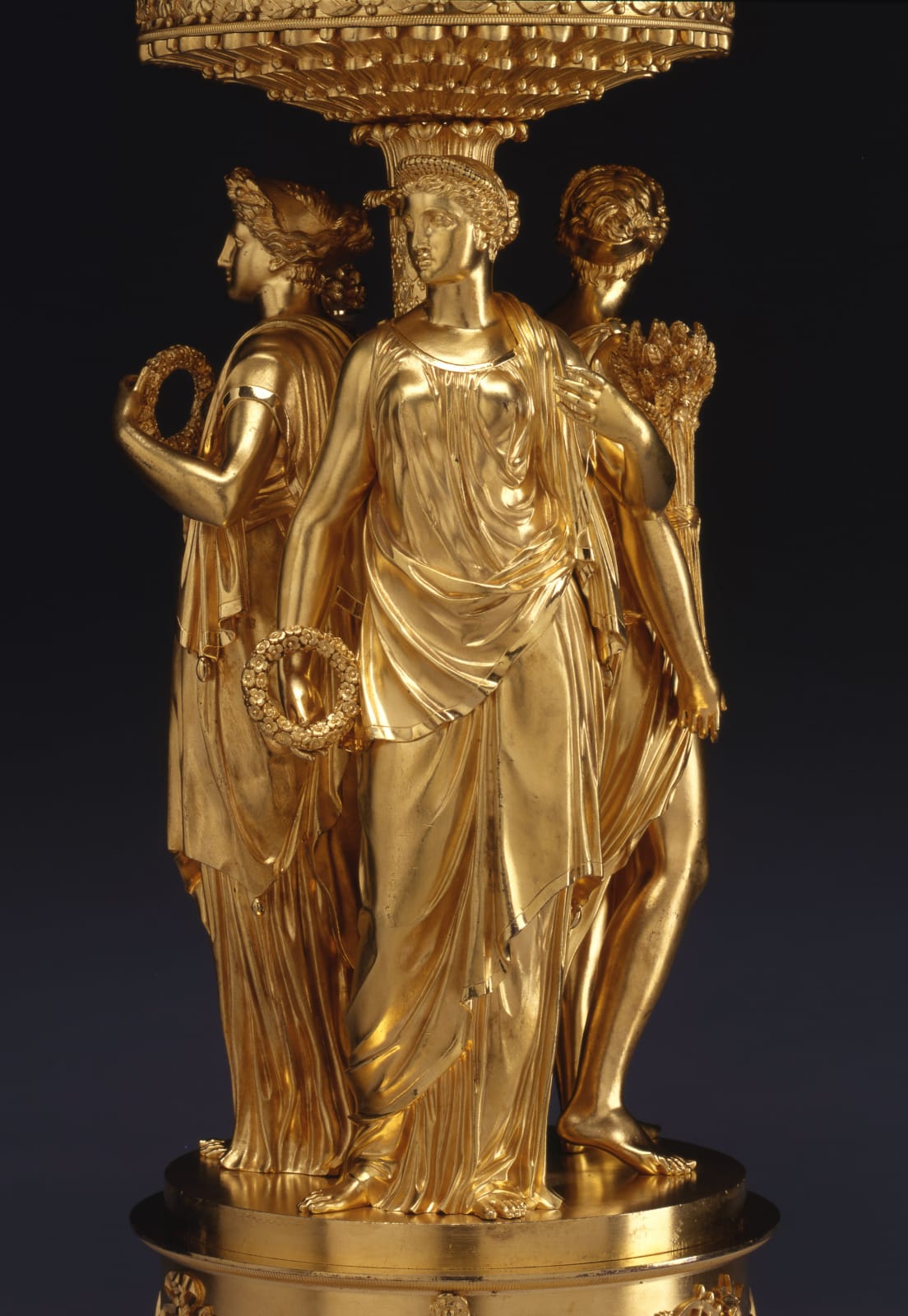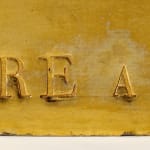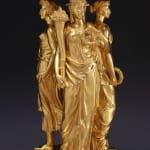Pierre-Philippe Thomire French, 1731-1843
Further images
Literature
Juliette Niclausse’s biography, “Thomire, fondeur-ciseleur 1751-1843: sa vie, son oeuvre”, 1947, pp. 129-130, lists ten complete and twelve incomplete surtouts de table and individual pieces. The largest set, owned by the Mobilier National, comprised 59 pieces. The Ministère de l’Intérieur and the Ministère de la Guerre both owned other surtouts. A very fine example, made for Napoleon’s brother, Prince Lucien Bonaparte is now in the Musée de Marmottan, Paris, illustrated in Hans Ottomeyer and Peter Pröschel, “Vergoldete Bronzen”, 1986, p. 382, pl. 5.16.2. This latter piece, made 1810-14 has a large central centrepiece (78 cm. high) with three dancing maidens, probably designed by Pierre Cartellier (1757-1831) and two smaller flanking candelabra with three standing maidens holding flaming torches, probably after a design by Pierre-Paul Prud’hon (1758-1823).
Another similar Thomire centrepiece with three dancing maenads forms part of the collection at Brighton Pavilion, illustrated in J. Dinkel, “The Royal Pavilion at Brighton”, circa 1985, p. 10. Instead of grouped maidens supporting a central basket, some Thomire centrepieces comprised two individual winged Victories, holding between them a fruit or flower basket, such as one of 1810, originally owned by the comtes de Pourtalès, now in the Gulbenkian Museum, Lisbon, illustrated in Ottomeyer and Pröschel, ibid. p. 382, pl. 5.16.1.
A very important Empire gilt bronze figural centrepiece with detachable nine-light candelabrum by Pierre-Philippe Thomire (1751-1843), stamped Thomire à Paris, with elaborate pierced basket ornamented with grapes and floral rosettes with removable ring with candle branches above a central shaped foliate pillar, flanked by three maidens representing Ceres, each holding wreaths, one holding a cornucopia, another holding a scythe, on a stepped circular pedestal applied with medallion rosettes, ribbon-tied floral garlands and lyres, on a foliate moulded spreading circular base
Paris, date circa 1810-15
Height 85 cm.
This magnificent centrepiece was almost certainly made as part of a ‘surtout de table’, an elaborate dining service, which in the early nineteenth century was displayed on a long mirrored plateau in the centre of a large dining table. This type of service was developed in France during the reign of Napoleon’s rule and in the wake of his various conquests was soon adopted throughout Europe. Pierre-Philippe Thomire (1751-1843), who was elected ciseleur de l’Empereur in 1809 in recognition of his service to Napoleon, created some of the very finest and most lavish surtouts for the Emperor and members of his Imperial court.
The centrepiece was intended to hold flowers or possibly fruit and as here was often fitted with a removable ring with candle branches. A typical complete surtout de table may have comprised 24 and even 59 pieces which would probably have included smaller flanking centrepieces, tiered bon-bon dishes and sweetmeat plates, fruit baskets, possibly vases and accompanying candelabra placed on both the mirrored plateau and around its sides. While some remain as complete sets many have inevitably been separated, not least due to the practicalities of smaller dining tables. Despite separation, individual pieces are still very highly prized, such as a comparable but slightly smaller centrepiece of 76 cm. high by Thomire, now in the Victoria and Albert Museum, London, which stands in pride of place in one of the entrance galleries (gallery 8). The central pillar supporting the openwork basket is surrounded by three similar dancing maidens, likewise the circular base is ornamented with swags and lyres; illustrated in “Art and Design in Europe and America”, introduced by Simon Jervis, 1987, p. 31.
A surtout, attributed to Thomire, owned by the Biblioteca Ambrosiana, Milan was shown at the London Royal Academy exhibition entitled “The Age of Neoclassicism”, 1972, no. 1768. Here the central and two accompanying centrepieces have three dancing maidens each holding the basket aloft. While another centrepiece with a Roman centurion and three maidens, similar to those in this work, is illustrated in J. Niclausse, ibid. pl. 20, The latter example is ornamented with various armorial trophies of war and as Niclausse notes was probably made for an Imperial General. Niclausse also notes that Prince Demidoff had once owned a Thomire surtout, part of which was purchased in 1880 by the eminent silversmiths, the House of Odiot.
Prince Demidoff, like Napoleon himself and the latter’s foreign minister Charles-Maurice de Talleyrand-Perigord amassed a large collection of silver and gilt table ornaments made by the very finest craftsmen such as Odiot and Thomire. Talleyrand recognised the idea that much could be gained by inviting visiting members of State to a lavish gastronomic entertainment, where both food and the table ornaments played an important part. At the same time the French, who had always enjoyed a long tradition of fine food began changing their eating habits. By about 1810 they had abandoned the popular eighteenth century tradition of the ‘service à la française’, where all courses were presented on the table at the same time in favour of the ‘service à la russe’, where food was presented one course at a time. This meant that although food was served hot direct from the kitchen the table, now devoid of all its dishes, appeared rather bare. As a consequence table ornaments became more lavish and at the same time the surtout de table was developed as a perfect solution to ornament the central area of a long dining table. As Niclausse, ibid. p. 92, notes ‘Le luxe de la table, ce décorum imposant qui était de rigueur, mit à la mode ces grands surtouts dont Thomire se fit une spécialité. Il eut le premier l’idée d’entourer d’une galerie de bronze les miroirs qui supportaient les pièces’ (from Froment-Meurice, ‘Nouvelles Archives de l’art français’, 1874-75, p. 481)
In keeping with the idea of lavish hospitality the three maidens who adorn this centrepiece personify Ceres, the mythological goddess of agriculture. She was especially associated with corn and as the personification of earth’s abundance was often portrayed with a crown of ears of corn. As here she is often represented holding a cornucopia usually filled with fruit and vegetables. Again as here, she is shown holding a scythe so as to harvest the corn. The third figure, which is now missing an item from her hand, was most probably holding a sheaf of corn, as this was another of Cere’s attributes. In addition each of the figures is holding a floral wreath, which not only looks aesthetically pleasing but also represent the fruits of nature while the grapes adorning the basket symbolize Bacchus, the wine god and thus complement the idea of plenty.
Perhaps more than any other type of object, the figural centrepiece allowed Thomire freedom to display his artistic mastery. For though he became the greatest fondeur-ciseleur he had originally trained as a sculptor under Houdon and Pajou at the Academie de Saint Luc. He then followed his father’s profession as a bronzier, becoming a maître in 1772. Two years later he was apprenticed under the celebrated ciseleur, Pierre Gouthière (1732-1813), from whom he acquired the art of fine chasing and gilding of bronzes. Thus in addition to the beauty of the figures and overall design one can admire the sophisticated surface finish of the soft matt areas known as dorure au matt and contrasting areas of highly gilded and brilliantly burnished gilt bronze.
Unfortunately records of similar pieces have become lost when sold at auction descriptions of complete surtouts de table and their individual pieces are only sparingly described. Thus like the comparable centrepiece at the Victorian and Albert Museum the original ownership of this particular piece is unknown.
However ots elaborate design and sheer size as well as comparisons with other similar works in prestigious collections all point to the fact that this centrepiece was made for a very important client. It would have formed part of a large surtout de table, fit only for the most elaborate table such one owned by Prince Demidoff or even Napoleon himself.
PIERRE-PHILIPPE THOMIRE (1731-1843). FRENCH
The Parisian, Pierre-Philippe Thomire was one of the greatest craftsmen to work in gilt bronze. He was patronised by the Louis XVI, Napoleon, Louis XVIII and Charles X as well as the English monarchy and European aristocracy Thomire had initially trained as a sculptor under Houdon and Pajou at the Academic St.Luc, but then followed his father's profession as fondeur-ciseleur. He studied under the great fondeur-doreur, Pierre Gouthiere (1732-C.1812), from whom he acquired the most refined skills in chasing and gilding, in particular matt gilding "dorure au mat", to produce a subtle grainy satin-like finish. Thomire was appointed a maitre fondeur, 1772, setting up his own business in 1776. In the same year he collaborated in the 4ecoration of the coronation coach for Louis XVI, which was followed by other royal commissions including gilt bronze fire dogs with flaming urns and sphinxes, 1786 for the Louvre. In 1788 he supplied a Louis XVI style fire grate and pair of columns to an English gentleman, purchased in 1987 by the Victoria and AlbertMuseum, London.
During the Revolution, Thomire prudently turned to the manufacture of arms and ammunition but returned to decorative bronzes after the Consulate and was soon employing 800 men. His pre-Revolutionary success was subsequently overshadowed by his fame during the Empire, when he supplied substantial commissions to the Imperial court and was appointed ciceleur de 1'Empereur, 1809. His works proved to be some of the purest and finest expression of the Empire style (promoted by Pierre Fontaine and Charles Percier), including Thomire's Vase de Marriage de 1'Empereur (Versailles) and other monumental Greek shaped urns delicately modelled with crisp foliage and figures in low relief or candelabra supported by winged Victories. In 1811, Thomire collaborated with Odiot in the making of a cradle for the King of Rome, designed by Proud'hon (Schatzkammer, Vienna). Thomire also worked the bronze for another Imperial cradle (Fontainebleau). After the Restoration, Thomire enjoyed the patronage of the Bourbons and was awarded the Legion d'Honneur by Louis-Philippe.
Thomire engaged upon a number of collaborations, due as much to the unparalled quality of his castings as to the pre-Revolutionary guild restrictions upon furniture porcelain and clockmakers. Thomire was employed by Sevres to produce fine ornamental pieces, including a pair of classical vases with ormulu mounts for Louis XVI, 1782(purchased by George IV, 1812). He also specialised in clock cases in Sevres porcelain and bronze, with movements by the best clockmakers such as Robert Robin, 1788(Musée des Arts Decoratifs, Paris). After the Revolution Thomire produced a number of bronze and gilt bronze clock cases, with compositions based upon neoclassical sculptural groups or paintings, such as his Rape of the Sabines clock, inspired by Jacques Louis David's painting, 1799. At other times he included Greek heroes, featured in the Apollo clock or Father Time who carries a clock upon his shoulder (both purchased by George IV). In addition Thomire frequently provided ormulu mounts to the leading furniture makers, including G. Benneman, F. Schwerdfeger and particularly A. Weisweiler. Thomire retired in 1823, though he continued to make sculptures; his firm Thomire et Cie was continued by his two sons.
Copyright by Richard Redding, Zurich. All rights reserved!









